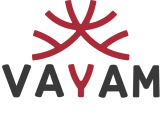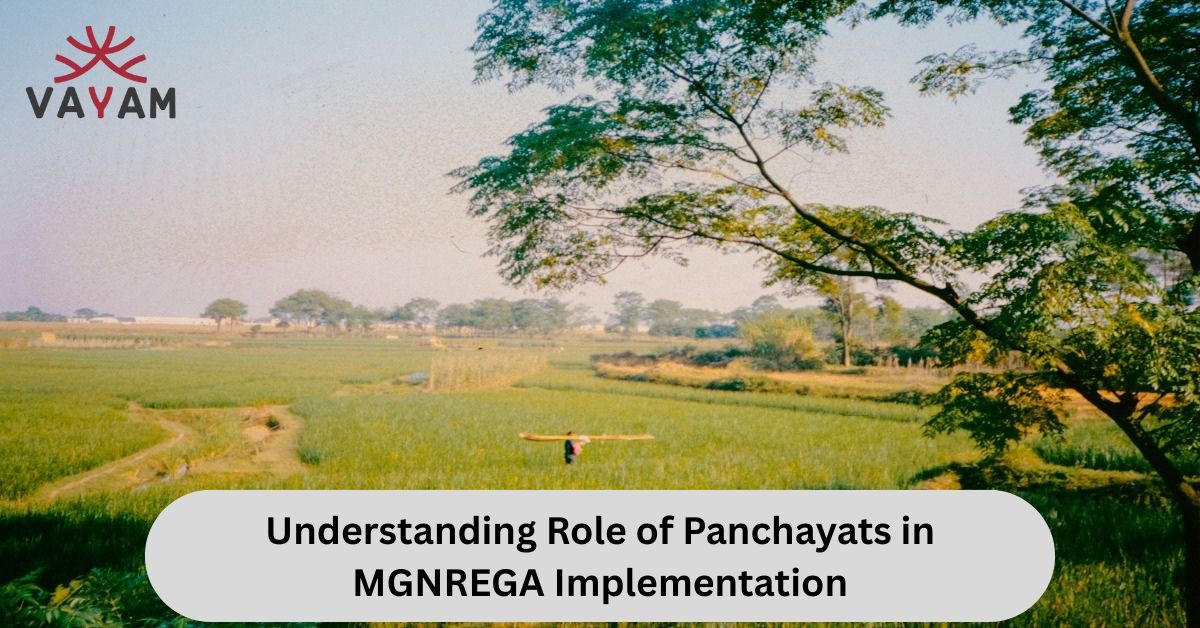
The Mahatma Gandhi National Rural Employment Guarantee Act (MGNREGA) represents one of India’s most ambitious social protection schemes, fundamentally transforming rural governance by placing local institutions at the center of implementation. The act doesn’t merely provide employment; it strengthens democratic decentralization by empowering Panchayati Raj Institutions (PRIs) with unprecedented planning, implementation, and monitoring responsibilities.
MGNREGA’s success hinges on the effective functioning of Panchayats, particularly Gram Panchayats, which serve as the primary implementing agencies for this demand-driven employment guarantee scheme.
The Constitutional Foundation of Panchayati Raj in MGNREGA
The three-tier Panchayati Raj system forms the backbone of MGNREGA implementation in India. Established through the 73rd Constitutional Amendment, this system comprises Gram Panchayats at village level, Panchayat Samitis at block level, and Zilla Panchayats at district level.
MGNREGA leverages this decentralized governance structure to ensure bottom-up planning and community participation. The act recognizes Panchayats as autonomous institutions capable of making independent decisions about local development priorities.
Under MGNREGA, at least 50 percent of works must be executed by Gram Panchayats, while some states like Jharkhand have made panchayats responsible for 100 percent implementation. This delegation of authority represents a significant shift from traditional top-down development approaches.
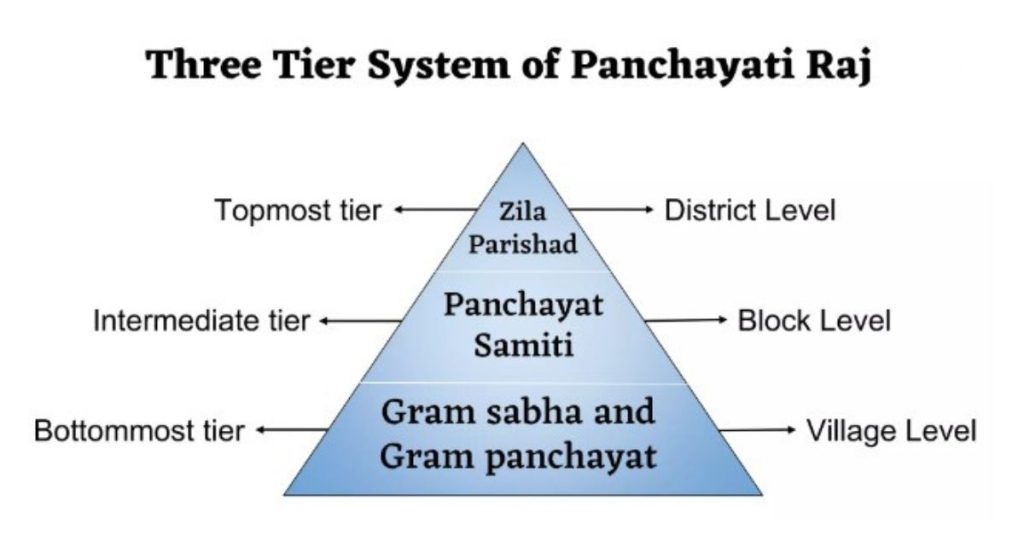
Gram Panchayats: The Implementation Powerhouse
Gram Panchayats serve as the pivotal body for MGNREGA implementation at the village level, carrying an extensive range of responsibilities that span the entire project lifecycle.
Core Functions and Responsibilities
Registration and Employment Provision
Gram Panchayats handle the fundamental processes of household registration, job card issuance, and employment allocation. They receive applications for both registration and work, verify applications, and ensure work provision within the mandated 15-day timeline.
Planning and Project Development
The planning process begins at the Gram Panchayat level, where local representatives identify potential works, develop project proposals, and create an annual shelf of projects. This bottom-up approach ensures that projects align with local needs and priorities.
Financial Management
Gram Panchayats maintain detailed accounts, provide utilization certificates, and prepare annual reports containing facts, figures, and achievements related to scheme implementation. They also have authority over supply orders for material procurement and satisfaction certificates for vendor payments.
Monitoring and Supervision
Village-level institutions conduct regular monitoring of ongoing works, verify muster rolls through Ward Members, and issue completion certificates necessary for scheme closure in the Management Information System.
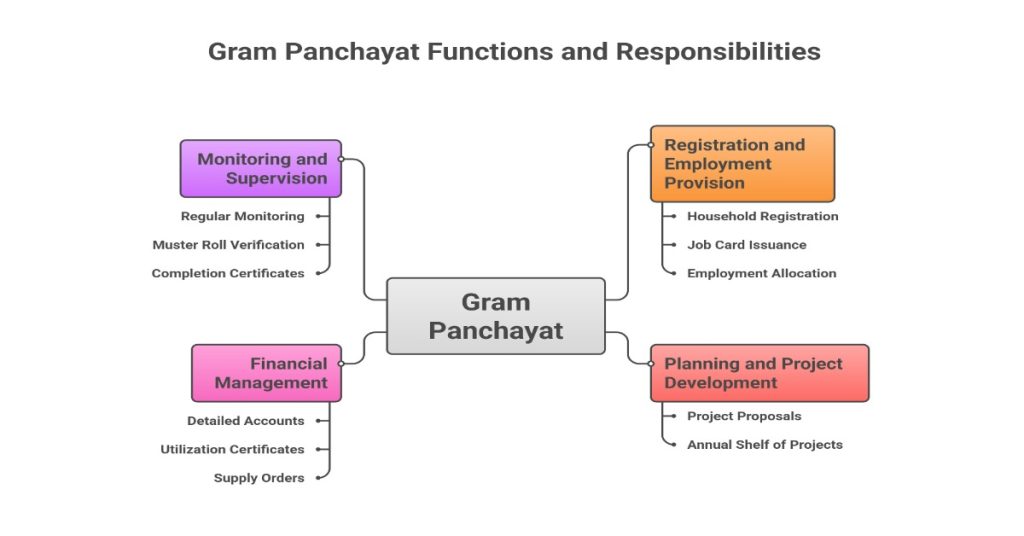
The Planning Process: From Village Vision to Reality
MGNREGA’s planning process exemplifies participatory democracy in action, beginning with village-level consultations and moving upward through administrative hierarchies.
Gram Sabha’s Central Role
The planning process starts with the Gram Sabha, which serves as the primary forum for identifying local needs and recommending works. Gram Sabhas meet at least twice yearly, with MGNREGA being a prime agenda item alongside other development initiatives.
During these meetings, community members discuss potential projects, assess labor demand, and prioritize works based on local requirements and available resources. The Gram Sabha determines the order of priority for works, keeping in view the potential of the local area, its needs, and local resources.
Labour Budget Preparation
Village councils estimate labor demand and prepare labor budgets accordingly, creating essential annual work plan documents that detail planning, approval, funding, and project execution modalities. These budgets include month-wise anticipated quantum of demand for work and schedules for work provision.
The labor budget is then consolidated upward at block, district, state, and national levels to prepare the annual labor budget for MGNREGA nationwide. This systematic approach ensures adequate resource allocation while maintaining local autonomy in project selection.
Social Audit: Ensuring Transparency and Accountability
Community members conducting a social audit in a rural setting, reflecting citizen oversight in rural development programs.
Social audit represents one of MGNREGA’s most innovative features, institutionalizing community-based monitoring and creating unprecedented transparency in government scheme implementation.
Legal Framework and Mandates
Section 17 of MGNREGA mandates Gram Sabhas to conduct social audits of all projects within their jurisdiction. The Audit of Scheme Rules, 2011, developed in collaboration with the Comptroller and Auditor General, outline detailed procedures for social audit implementation.
Social Audit Process
Social audits are periodic assemblies convened by Gram Sabhas where all project details are scrutinized through public participation. These audits involve quality checks of infrastructure created, verification of financial transactions, identification of procedural deviations, and assessment of wage payments.
The process includes reviewing official records, determining whether reported expenditures reflect actual ground-level spending, and providing a platform for beneficiaries to raise concerns and seek redressal.
Institutional Support
Independent Social Audit Units (SAUs) facilitate the audit process, operating separately from implementing agencies to ensure unbiased evaluation. These units receive funding equivalent to 0.5% of state MGNREGA expenditure from the previous year, ensuring adequate resources for thorough audits.

Implementation Challenges at the Panchayat Level
Despite MGNREGA’s robust design, Panchayats face several challenges that impact effective implementation.
Administrative and Technical Capacity
Many Gram Panchayats lack adequate administrative and technical manpower, particularly at the Programme Officer and Employment Guarantee Assistant levels. This shortage affects plan preparation, work scrutiny, approval processes, monitoring, and record maintenance.
Financial and Authority Constraints
While Panchayats have significant responsibilities, they often lack corresponding financial powers and administrative authority. The centralized payment system and MIS-based implementation have reduced local representatives’ role in grievance redressal and payment authorization.
Awareness and Capacity Building
Limited awareness of legal frameworks, especially among local communities, impedes active involvement in social audits and scheme implementation. Many Panchayat members remain unaware of their rights and powers under MGNREGA.
Political and Social Dynamics
Political influence can hinder impartial implementation and social audit processes. Local power structures and caste-based segregation continue to affect equitable access to employment opportunities.
Grievance Redressal: Multi-Level Support System
MGNREGA establishes a comprehensive grievance redressal mechanism spanning multiple administrative levels to ensure timely resolution of beneficiary complaints.
Programme Officer Level
Programme Officers at block level serve as the first point of contact for grievances, mandated to dispose of complaints within seven days of receipt. They maintain complaint registers and provide written acknowledgments with receipt and acknowledgment dates.
District Ombudsman System
The District Ombudsman serves as an autonomous authority for grievance redressal, handling complaints related to violations attracting penalties under Section 25 of MGNREGA. However, many states have failed to appoint adequate numbers of Ombudsmen, creating gaps in the grievance redressal system.
Multiple Complaint Channels
The system provides various modes for complaint registration, including written applications, telephone helplines, online platforms, and social audit processes. All complaints are recorded and made available in the public domain through web-based systems.
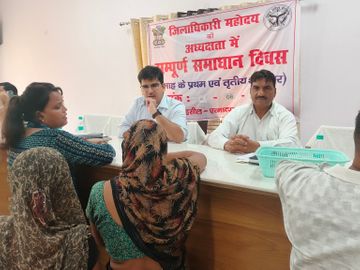
Success Stories and Best Practices
Several states have demonstrated innovative approaches to strengthening Panchayat-led MGNREGA implementation.
Jharkhand’s Comprehensive Model
Jharkhand has implemented a comprehensive approach where Panchayats handle 100% of MGNREGA implementation. The state established weekly “Rojgar Diwas” (Employment Days) at Panchayat Bhawans, centralizing all MGNREGA transactions including job card applications, work demands, and document preparation.
This initiative transformed previously locked Panchayat buildings into active centers of local administration, ensuring regular service delivery to citizens.
Technology Integration
States have successfully integrated technology solutions while maintaining Panchayat autonomy. The Management Information System (MIS) generates automatic alerts for deviations and non-compliance while providing robust platforms for information dissemination.
Convergence Initiatives
Successful implementations often involve convergence with other government schemes, creating synergies between MGNREGA and programs like Swachh Bharat Abhiyan, rural housing initiatives, and natural resource management projects.
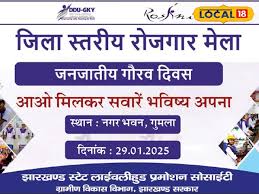
What is the role of Gram Sabha in MGNREGA implementation?
Gram Sabha serves as the democratic foundation of MGNREGA implementation with several critical responsibilities. It determines the order of priority for works based on local area potential, needs, and available resources. The Gram Sabha monitors execution of works within the Gram Panchayat and serves as the primary forum for conducting social audits.
Additionally, it provides a platform for all residents to seek and obtain relevant information from implementing agencies about MGNREGA works. The Gram Sabha’s recommendations form the basis for the Gram Panchayat’s development plan, ensuring community-driven project selection.
How do Panchayats conduct social audits under MGNREGA?
Panchayats conduct social audits through mandatory Gram Sabha meetings held at least once every six months. During these assemblies, all project details are scrutinized publicly, including muster rolls, bills, vouchers, measurement books, and sanction orders.
The Gram Panchayat makes all relevant documents available to the Gram Sabha for audit purposes. Independent Social Audit Units facilitate the process, providing technical support while maintaining separation from implementing agencies. The audit process involves community verification of work quality, wage payments, and adherence to prescribed procedures.
What are the main challenges in MGNREGA implementation at village level?
Village-level implementation faces several significant challenges. Administrative capacity constraints include inadequate manpower at Programme Officer and technical assistant levels, affecting planning, monitoring, and record maintenance.
Financial challenges include delays in wage payments, with most states failing to disburse wages within the mandated 15-day period. Limited autonomy of Panchayati Raj Institutions restricts effective implementation despite extensive responsibilities.
Social challenges include caste-based segregation in work allocation and payment delays, with significant variations between different community groups. Additionally, corruption, fake job cards, and quality issues in asset creation continue to affect programme effectiveness.
How does the grievance redressal mechanism work in MGNREGA?
The grievance redressal mechanism operates through multiple levels and channels. At the block level, Programme Officers must dispose of complaints within seven days, maintaining complaint registers and providing written acknowledgments.
The District Ombudsman handles complaints involving legal violations and penalty provisions. Multiple complaint channels include written applications, telephone helplines, online platforms, and social audit processes.
However, implementation faces challenges due to inadequate appointment of Ombudsmen and insufficient coordination between various levels. The system aims to provide accessible, timely resolution while maintaining transparency through public domain complaint tracking.
What powers do Gram Panchayats have in the MGNREGA scheme?
Gram Panchayats possess extensive powers spanning the entire MGNREGA implementation cycle. They have authority to allocate work to workers against work demands and issue work orders to field supervisors.
Financial powers include authority for Mukhiyas to sign Fund Transfer Orders as second signatories and issue supply orders for material procurement. Administrative powers encompass issuing completion certificates necessary for scheme closure and providing satisfaction certificates for material payments.
Planning powers include developing a shelf of projects, determining work priorities, and forwarding project lists to Programme Officers for approval. Monitoring powers include Ward Member verification of muster rolls and regular scheme supervision at village level.
Read More
The Environmental Impact of MGNREGA: Building Sustainable Communities
Top 5 MGNREGA Success Stories You Need to Know
Understanding MGNREGA’s Unemployment Allowance: Are You Eligible?
The Path Forward: Strengthening Panchayat-Led Implementation
MGNREGA’s success in transforming rural governance depends on continued strengthening of Panchayat capabilities and addressing implementation challenges systematically.
Capacity Building and Training
Regular training programs for Panchayat members, technical staff, and community facilitators can address knowledge gaps and improve implementation quality. Focus should be placed on financial management, project planning, and social audit procedures.
Technology Integration with Local Control
While maintaining the benefits of digital systems, states should ensure that technology enhances rather than replaces Panchayat authority. Provisions for local-level transactions, including muster roll generation and payment authorization, should be strengthened.
Financial Empowerment
Providing Gram Panchayats with greater financial autonomy, including control over administrative funds and sanctioning powers, would enable more responsive and efficient implementation.
Convergence and Innovation
Encouraging convergence with other rural development schemes while supporting local innovations can maximize MGNREGA’s impact on rural transformation.
The role of Panchayats in MGNREGA implementation represents a fundamental shift toward participatory governance and community-driven development. While challenges remain, the framework established by MGNREGA has created unprecedented opportunities for strengthening local democracy and ensuring transparent, accountable governance at the grassroots level. Success depends on continued commitment to empowering these institutions with adequate resources, authority, and support systems necessary for effective implementation of this transformative legislation.
